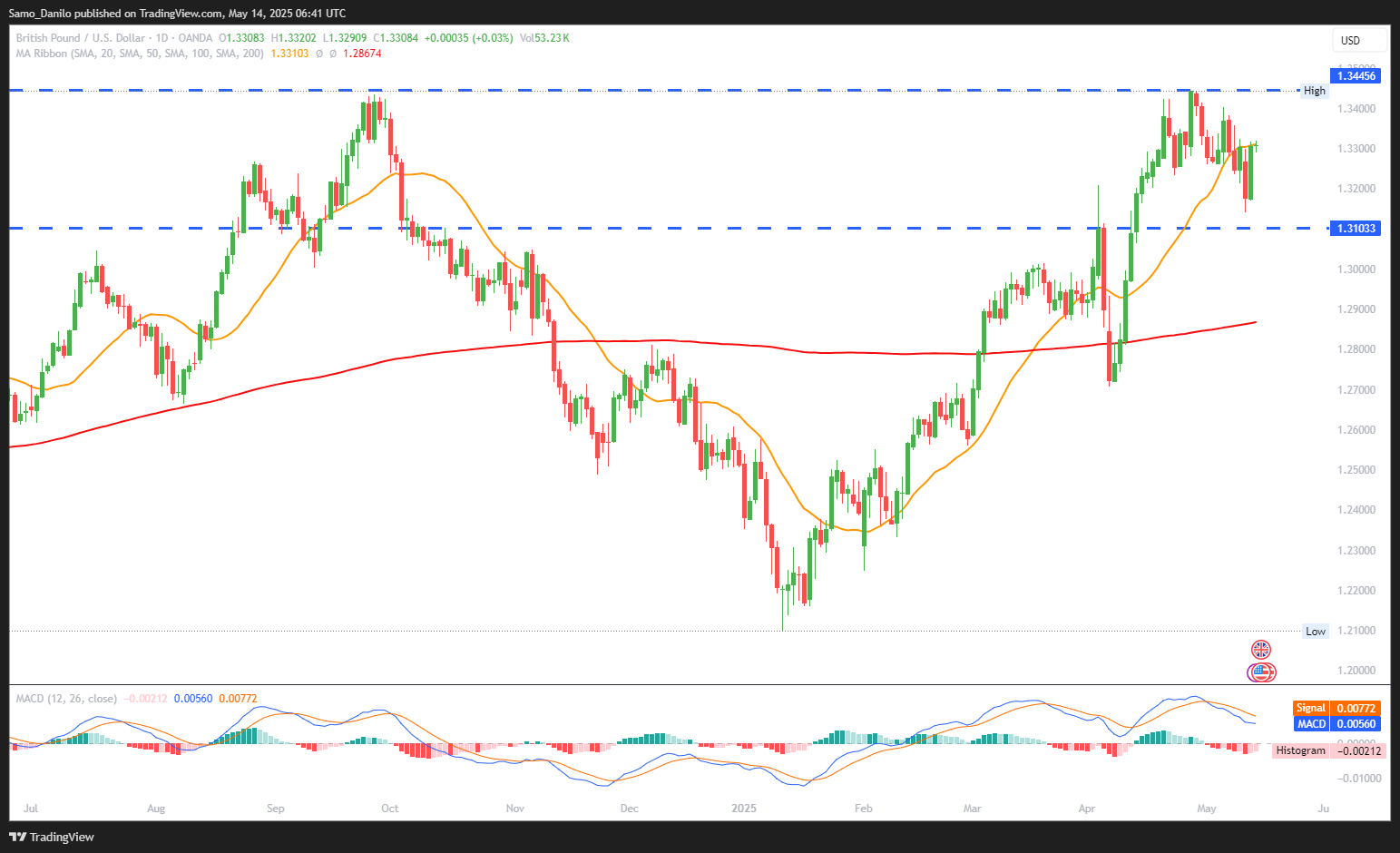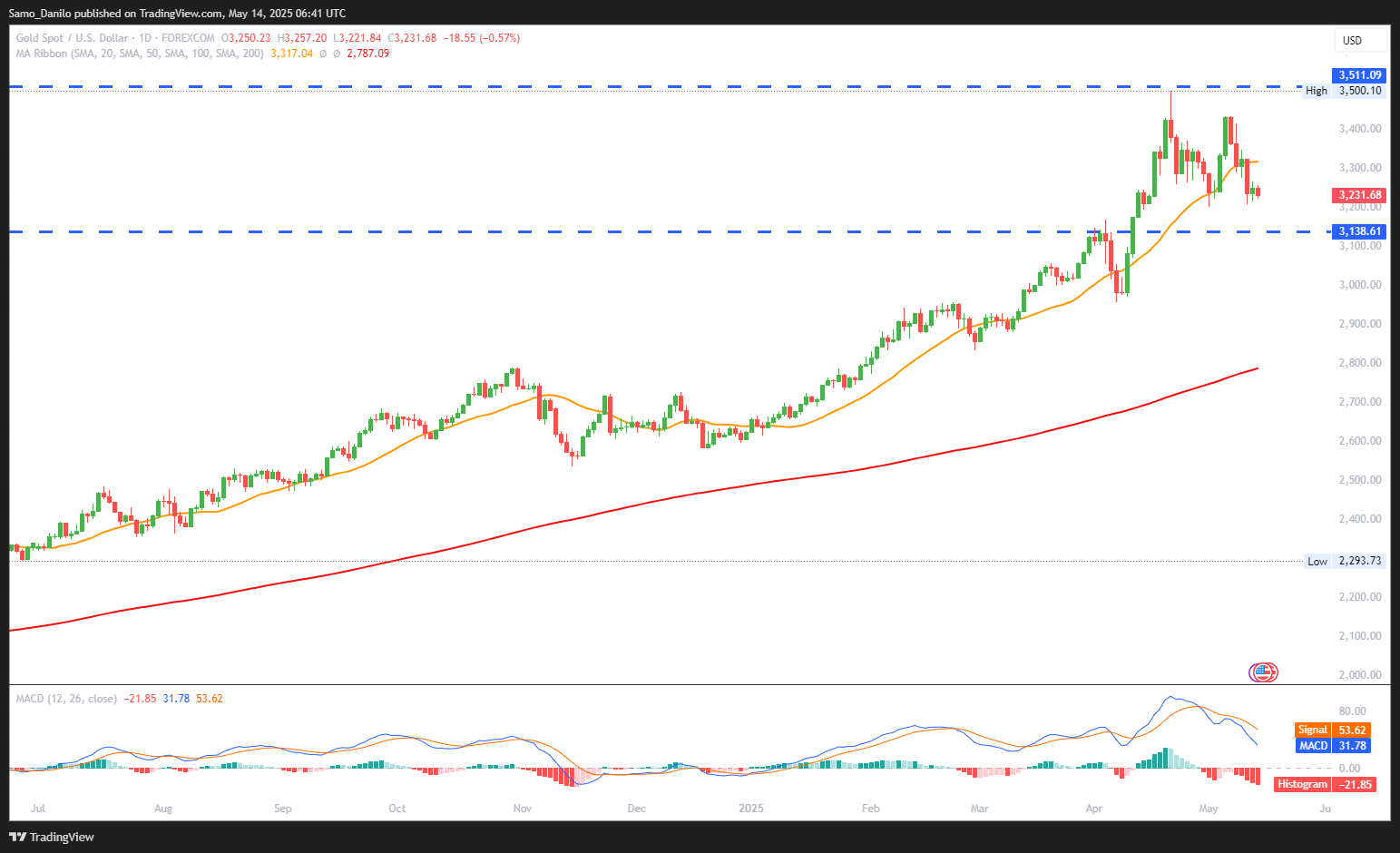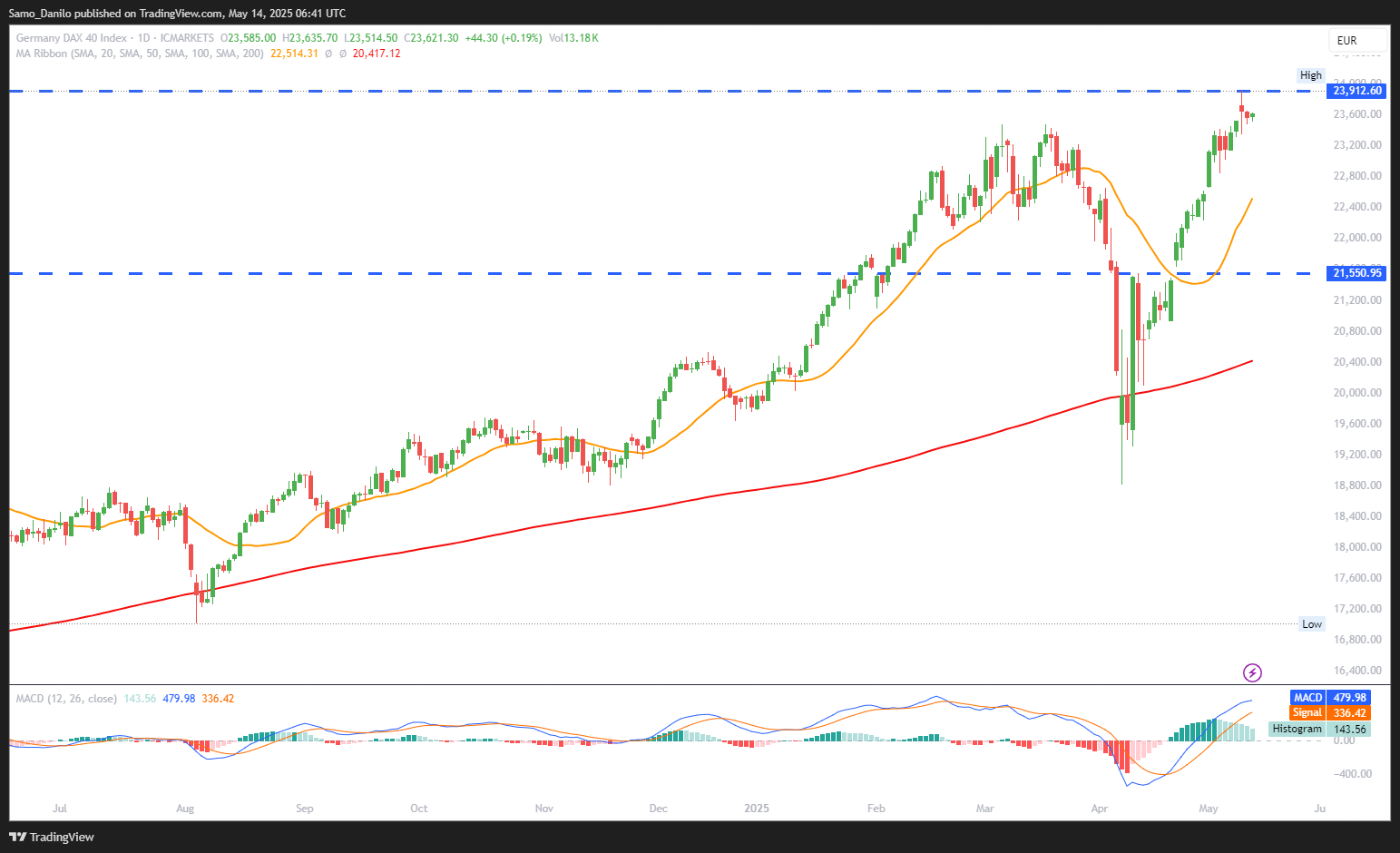EURUSD
- EUR/USD Price: The EUR/USD pair rises to around 1.1195 during Wednesday’s European session, recovering modestly on the back of weaker-than-expected US CPI data. The lower inflation print has cooled expectations for aggressive Fed action, weakening the US Dollar.
- US CPI: April's US Consumer Price Index (CPI) fell to 2.3% YoY, below the consensus of 2.4%. The decline has boosted speculation of earlier Fed rate cuts, pushing Treasury yields lower and supporting the EUR/USD rebound.
- US-China Trade: Markets welcomed a surprise tariff de-escalation from both the US and China following negotiations in Geneva. The US reduced duties on Chinese imports to 30% from 145%, while China responded with a cut to 10% from 125%. This boosted risk sentiment, although USD reaction remained subdued.
- ECB Outlook: Money markets are now pricing an ECB deposit rate around 1.80% by year-end, slightly above mid-April levels. Despite ongoing rate cut speculation, the rate expectations suggest markets see limited ECB easing ahead, lending mild support to the euro.
- Eurozone GDP: The market now turns its attention to Q1 Pan-European GDP figures, due Thursday. Expectations are for no material change from the prior quarter, potentially keeping EUR/USD movements rangebound unless a surprise shifts sentiment.
Closing statement: EUR/USD is recovering as softer US inflation data and easing global trade tensions lift near-term sentiment. However, ECB rate expectations and upcoming Eurozone GDP will be pivotal in determining whether the pair can sustain momentum above the 1.1200 threshold.
GBPUSD
- GBP/USD Price: The GBP/USD pair trades around 1.3300 during Wednesday’s European session, stabilizing after posting over 1% gains on Tuesday. The consolidation reflects a wait-and-see mood ahead of key UK macro releases.
- UK Labor Data: UK labor market data was mixed but broadly stable, with the ILO Unemployment Rate ticking up to 4.5%, in line with forecasts. Meanwhile, April’s Claimant Count Change surprised to the downside, rising just 5.2K vs expectations of a larger increase.
- BoE’s Mann: BoE’s Catherine Mann remarked that the labor market has shown more resilience than expected, though she flagged rising household inflation expectations as a concern.
- UK Data: Attention now shifts to Thursday’s UK Q1 GDP, Industrial, and Manufacturing Production figures. Markets expect 0.6% quarterly GDP growth, which, if met or exceeded, could reinforce GBP strength in the near term.
- US Data: On the US side, upcoming PPI inflation and consumer sentiment data (University of Michigan) are expected to influence Fed rate path expectations. Softer prints may continue to weigh on the USD, potentially favoring GBP/USD upside.
Closing statement: GBP/USD is stabilizing around 1.3300 as investors await key UK economic data and fresh US inflation signals. A positive UK GDP surprise could bolster the pound, while soft US figures would weigh on the dollar, keeping the pair biased to the upside.
XAUUSD
- XAU/USD Price: Gold prices edge lower to around $3230 on Wednesday as risk sentiment improves on the back of a renewed US-China trade truce, weighing on demand for traditional safe-haven assets like gold.
- Fed Rate Cut: Despite April’s softer US CPI, expectations for the Fed's next rate cut have been delayed from July to September, putting pressure on non-yielding gold. The shift reflects a more cautious Fed stance, limiting immediate upside for the yellow metal.
- Trade Optimism: Market sentiment remains upbeat on the prospect of further US trade agreements with India, Japan, and South Korea, following recent deals with the UK and China. This reduces geopolitical risk premiums, undermining safe-haven flows into gold.
- Russia-Ukraine Talks: For the first time since 2022, Russia and Ukraine will hold high-level face-to-face talks in Istanbul. Hopes for a 30-day ceasefire, supported by US officials including Secretary Rubio, have added to global risk-on tone, further pressuring gold.
- Fed Outlook: While traders are pricing in 56 bps of Fed rate cuts in 2025, this has failed to attract significant USD demand in the near term. Nonetheless, it also limits gold’s upside, as the long-term easing trajectory is already largely priced in.
Closing statement: Gold remains on the defensive near $3230 as trade optimism and delayed Fed cuts dampen safe-haven appeal. Unless fresh geopolitical or inflation risks emerge, the yellow metal may stay rangebound or drift lower in the short term.
CRUDE OIL
- Crude Oil Price: WTI crude oil trades around $63.30 during Wednesday’s European session, holding recent gains but showing signs of upside exhaustion amid mixed global supply and geopolitical signals.
- US Crude Stocks: The API reported a significant inventory build of 4.287 million barrels for the week ending May 9, reversing the prior week’s sharp drawdown. This unexpected rise in US crude stockpiles signals softer demand or stronger domestic production, capping oil’s rally.
- Geopolitical Tensions: The Israeli military said it intercepted a hypersonic ballistic missile fired by the Iran-aligned Houthis militia group towards Ben Gurion Airport near Tel Aviv from Yemen on Tuesday evening.
- OPEC+ Output: OPEC+ is expected to raise exports in May and June, with production set to rise by 411,000 bpd, exceeding previous expectations. The supply boost could limit further upside, especially as global demand indicators remain mixed.
- Trump Talks: On the political front, President Trump emphasized improving US-China trade relations and expanding US market access to China. While this adds to the broader risk-on mood, its impact on oil demand remains speculative in the short term.
Closing statement: Crude oil prices are steady near $63.30 but face headwinds from rising US inventories and increased OPEC+ supply. Unless geopolitical risks intensify or US economic data surprises to the upside, WTI may struggle to sustain further gains in the near term.
DAX
- DAX Price: The DAX climbed for a fourth consecutive session, gaining 0.31% on Tuesday, May 13, to mark a new record closing high, driven by optimism surrounding US-EU trade developments and solid corporate earnings.
- Auto Sector: Germany’s auto giants led the rally, with Volkswagen up 3.76%, BMW gaining 3.02%, and other major players like Mercedes-Benz and Porsche also advancing. The sector was buoyed by growing hopes of a US-EU trade pact, potentially easing export headwinds.
- Corporate Earnings: Bayer surged 2.83% on a strong earnings beat, but Munich Re and Hannover Re dropped sharply—4.55% and 4.44% respectively—after revealing losses tied to US wildfire claims, underscoring sector-specific volatility despite the broader rally.
- German Sentiment: ZEW Economic Sentiment Index jumped to 25.2 in May from -14 in April, signaling renewed investor optimism as inflation steadies, political uncertainty wanes, and transatlantic trade tensions ease. This supports the bullish momentum in German equities.
- April CPI: Germany’s final April CPI came in at 2.1% YoY, confirming preliminary readings. However, core inflation ticked higher to 2.9%, suggesting persistent underlying price pressures that may complicate the ECB’s rate path going forward.
Closing statement: The DAX’s fresh record highlights renewed confidence in Germany’s economic trajectory, powered by auto sector strength and improving sentiment. However, elevated core inflation and pockets of corporate stress suggest a cautious approach beyond near-term gains.




